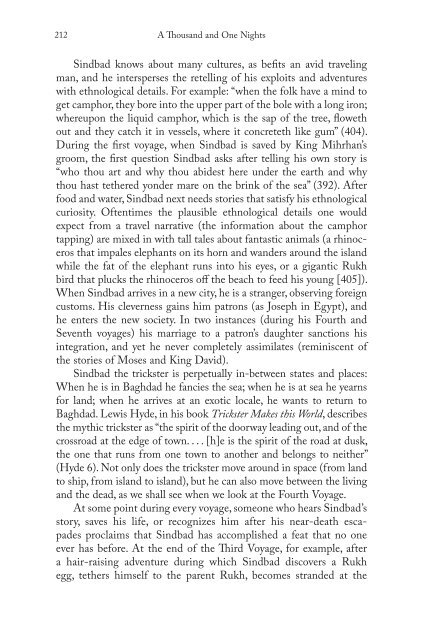Blooms Literary Themes - THE TRICKSTER.pdf - ymerleksi - home
Blooms Literary Themes - THE TRICKSTER.pdf - ymerleksi - home
Blooms Literary Themes - THE TRICKSTER.pdf - ymerleksi - home
You also want an ePaper? Increase the reach of your titles
YUMPU automatically turns print PDFs into web optimized ePapers that Google loves.
212<br />
A Th ousand and One Nights<br />
Sindbad knows about many cultures, as befi ts an avid traveling<br />
man, and he intersperses the retelling of his exploits and adventures<br />
with ethnological details. For example: “when the folk have a mind to<br />
get camphor, they bore into the upper part of the bole with a long iron;<br />
whereupon the liquid camphor, which is the sap of the tree, fl oweth<br />
out and they catch it in vessels, where it concreteth like gum” (404).<br />
During the fi rst voyage, when Sindbad is saved by King Mihrhan’s<br />
groom, the fi rst question Sindbad asks after telling his own story is<br />
“who thou art and why thou abidest here under the earth and why<br />
thou hast tethered yonder mare on the brink of the sea” (392). After<br />
food and water, Sindbad next needs stories that satisfy his ethnological<br />
curiosity. Oftentimes the plausible ethnological details one would<br />
expect from a travel narrative (the information about the camphor<br />
tapping) are mixed in with tall tales about fantastic animals (a rhinoceros<br />
that impales elephants on its horn and wanders around the island<br />
while the fat of the elephant runs into his eyes, or a gigantic Rukh<br />
bird that plucks the rhinoceros off the beach to feed his young [405]).<br />
When Sindbad arrives in a new city, he is a stranger, observing foreign<br />
customs. His cleverness gains him patrons (as Joseph in Egypt), and<br />
he enters the new society. In two instances (during his Fourth and<br />
Seventh voyages) his marriage to a patron’s daughter sanctions his<br />
integration, and yet he never completely assimilates (reminiscent of<br />
the stories of Moses and King David).<br />
Sindbad the trickster is perpetually in-between states and places:<br />
When he is in Baghdad he fancies the sea; when he is at sea he yearns<br />
for land; when he arrives at an exotic locale, he wants to return to<br />
Baghdad. Lewis Hyde, in his book Trickster Makes this World, describes<br />
the mythic trickster as “the spirit of the doorway leading out, and of the<br />
crossroad at the edge of town. . . . [h]e is the spirit of the road at dusk,<br />
the one that runs from one town to another and belongs to neither”<br />
(Hyde 6). Not only does the trickster move around in space (from land<br />
to ship, from island to island), but he can also move between the living<br />
and the dead, as we shall see when we look at the Fourth Voyage.<br />
At some point during every voyage, someone who hears Sindbad’s<br />
story, saves his life, or recognizes him after his near-death escapades<br />
proclaims that Sindbad has accomplished a feat that no one<br />
ever has before. At the end of the Th ird Voyage, for example, after<br />
a hair-raising adventure during which Sindbad discovers a Rukh<br />
egg, tethers himself to the parent Rukh, becomes stranded at the

















